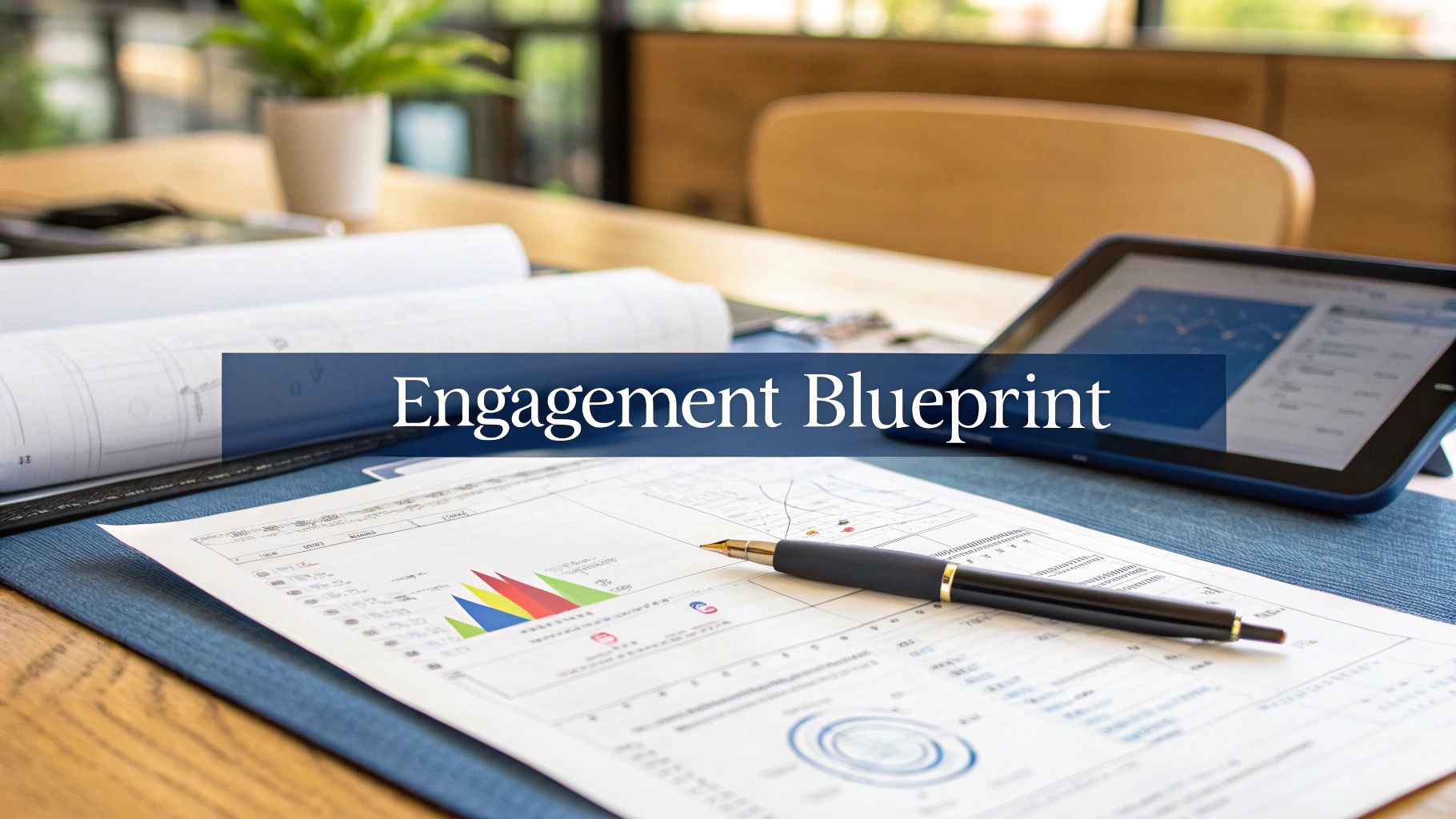A customer engagement plan is more than just a document; it's the strategic blueprint your business uses to build real, lasting relationships with your audience. Think of it as the master plan that guides every single interaction, from the first time someone hears about you to the moment they become a loyal advocate.
This framework ensures every touchpoint is intentional and consistent, strengthening the customer's connection to your brand every step of the way.
Decoding Your Customer Engagement Blueprint
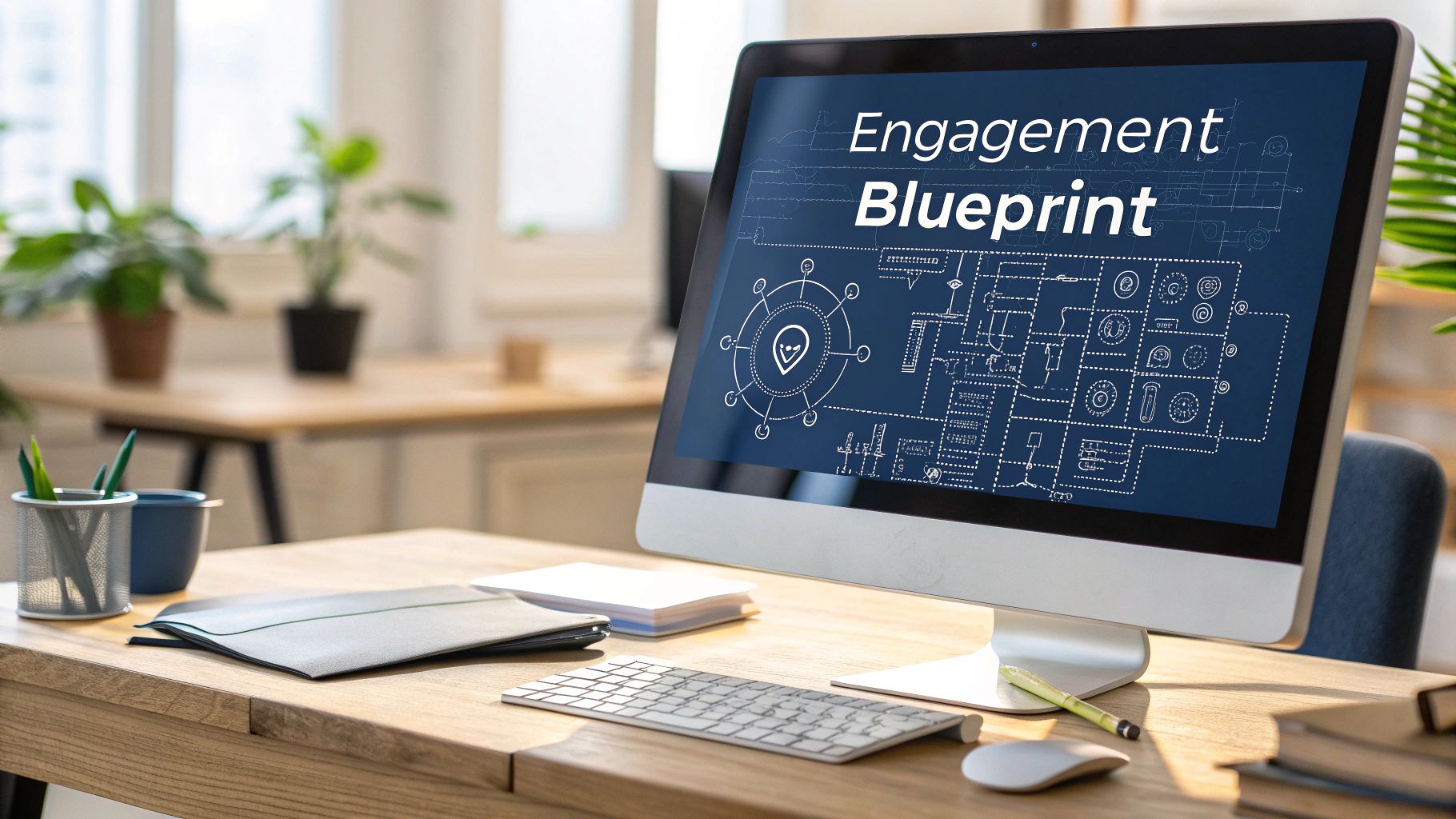
Let's dig a bit deeper. A customer engagement plan isn't a rigid set of rules. It's an architect’s detailed drawing for building a strong, enduring structure—and in this case, that structure is your customer relationships. Without this blueprint, your interactions are just random acts of marketing, disconnected and lacking a unified purpose.
This plan directs everything from the first ad a person sees to the support ticket they submit months later. The goal is simple: make sure every action adds value and reinforces the bond. In a world where loyalty is earned, not just expected, a formal plan isn't a nice-to-have; it's essential.
The Big Shift: From Satisfaction to Partnership
It's easy to mix up customer engagement with customer satisfaction, but they're worlds apart. Satisfaction is often passive and transactional. It answers the question, "Was the customer happy with this one purchase?"
Engagement, on the other hand, is an active, ongoing relationship.
A strong customer engagement plan moves you from just making customers happy to building a genuine two-way conversation. This dialogue is what drives real business results—higher retention, bigger lifetime value, and customers who become your most powerful advocates.
This is a fundamental shift from a transactional mindset to a relational one. Engaged customers don't just buy from you; they invest in you. They're more forgiving when things go wrong, they offer priceless feedback, and they are 40% more likely to spend more on your products.
The Four Pillars of a Customer Engagement Plan
Every solid engagement plan is built on a few core pillars. Let's break down the foundational components that will help you craft a strategy that truly works.
The Four Pillars of a Customer Engagement Plan
| Pillar | Description | Example Action |
|---|---|---|
| Audience Understanding | Go beyond basic demographics. Create detailed buyer personas and map out their entire journey to pinpoint key moments of interaction and opportunity. | Develop a journey map that identifies pain points during the post-purchase phase, then create targeted content to address them. |
| Clear Objectives | What do you really want to achieve? Set specific, measurable goals that are tied to business outcomes. | Instead of "improve engagement," set a goal like "reduce customer churn by 10% in Q3." |
| Channel Selection | You can't be everywhere at once. Identify the most effective channels—email, social media, SMS, or in-app messaging—to reach your specific audience segments. | If your audience is primarily Gen Z, you might prioritize TikTok and Instagram over email newsletters for certain campaigns. |
| Measurement & Optimization | Engagement isn't a "set it and forget it" activity. Your plan must include key performance indicators (KPIs) to track progress and make data-driven adjustments. | Regularly track metrics like Net Promoter Score (NPS), Customer Lifetime Value (CLV), and session duration to see what's working and what's not. |
Ultimately, these pillars come together to form your roadmap. It's what turns a simple customer list into a thriving, loyal community. A great customer engagement plan is the difference between having a business people buy from and building a brand they genuinely want to be a part of.
Why an Engagement Plan Is Critical for Growth
Let's move past the theory and talk about what really matters: your bottom line. A solid customer engagement plan isn't just about making customers feel good; it's a direct engine for business growth. It completely changes how you attract, keep, and serve your audience.
Engaged customers are more than just satisfied—they're more valuable. They buy more often, spend more each time, and are far more likely to try out your other products. This turns your customer list from a set of one-off transactions into a reliable stream of revenue.
The Real Cost of Neglecting Engagement
On the flip side, ignoring engagement is a costly mistake. Too many companies get stuck on the hamster wheel of chasing new customers, a process that’s five to 25 times more expensive than just keeping the ones you already have. A formal plan shifts your focus to the most profitable group you have: your current customers.
This strategic pivot directly boosts your profitability. When you focus on building loyalty and stopping customers from leaving, you lower your customer acquisition costs (CAC) and increase customer lifetime value (CLV). The result? A more efficient, predictable, and profitable business. You can explore a variety of customer retention strategies for small business to start building those stronger relationships today.
This infographic breaks down the financial payoff of a great engagement strategy, showing clear wins in customer spending, retention, and marketing efficiency.
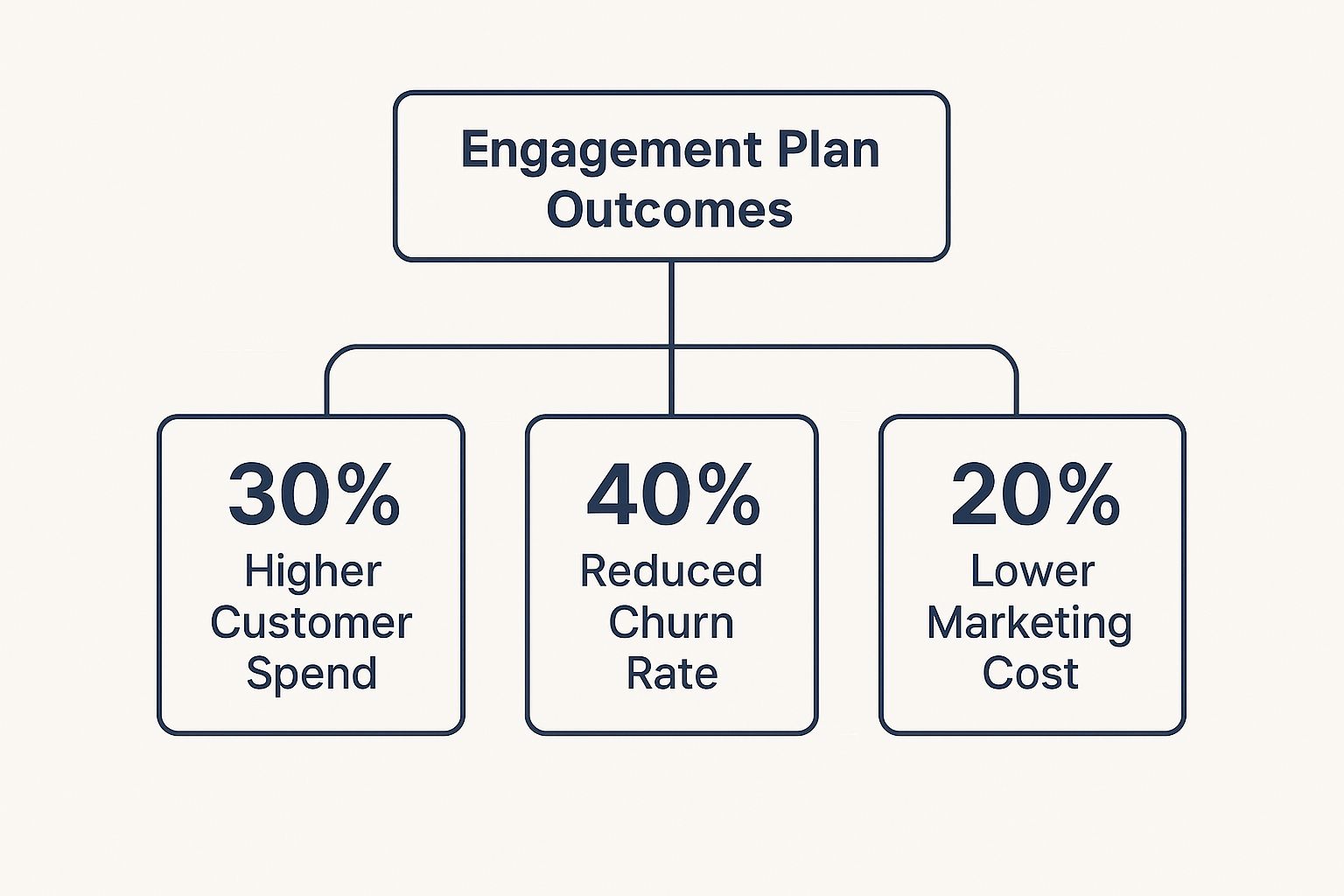
As you can see, the benefits are huge. A structured plan leads directly to major improvements across your most important business metrics.
Surviving the Expectation Economy
Today's customers expect more than ever. They want personalized, instant, and helpful interactions every single time. Brands that can’t deliver aren’t just falling behind; they're actively hurting their own reputation and revenue.
In a world full of choices, your engagement plan is what sets you apart. Competitors can copy your products or match your prices, but they can't easily replicate the genuine, trust-based relationships you've built with your customers.
This isn't just a hunch. The data shows a widening gap between what customers want and what brands are actually delivering. For instance, recent research from Forrester shows a troubling trend: in the US, 25% of brands saw their customer experience scores drop for the second year in a row, while only a tiny 7% improved. This gap is a massive opportunity for companies willing to get serious about their engagement efforts.
Turning Customers into Brand Champions
One of the best results of a great engagement plan is turning happy customers into your biggest fans. When customers feel like you actually see them, hear them, and value them, they can't wait to tell their friends about it.
This kind of organic, word-of-mouth marketing is pure gold for a few reasons:
- Trust: People trust recommendations from friends and family way more than ads. A Nielsen report found that 92% of consumers trust recommendations from people they know.
- Cost-Effectiveness: This kind of marketing is basically free. It slashes your ad spend and makes your marketing budget go a lot further.
- Quality Leads: Referrals from happy customers are usually a perfect fit for your business because they already understand the value you offer.
At the end of the day, a customer engagement plan is more than just a document—it's an investment in your company's future. It drives growth by getting more revenue from existing customers, cuts costs by improving retention, and builds an army of brand advocates who market for you.
The Core Components of an Effective Plan
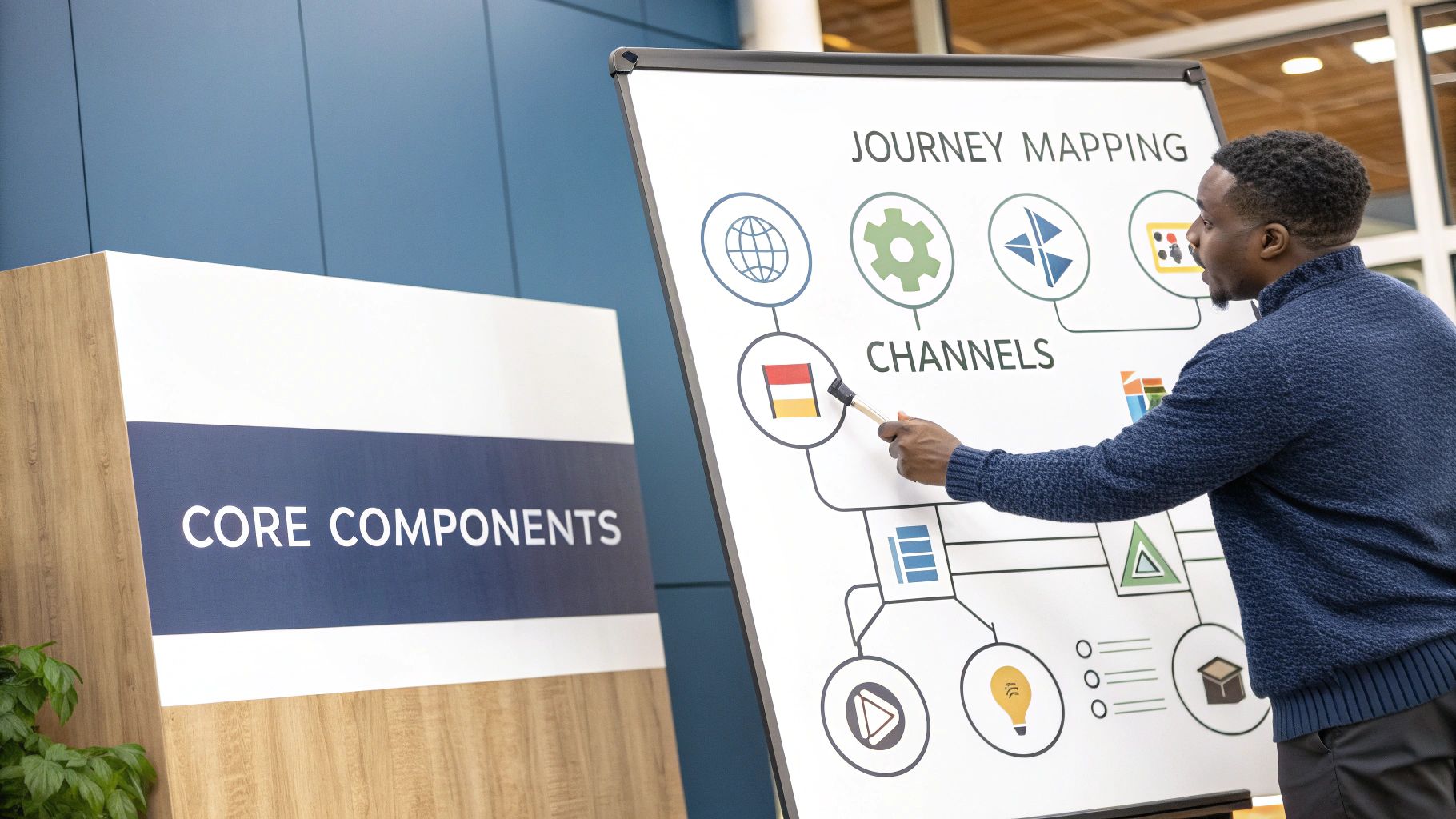
A great customer engagement plan isn't some massive, single document you create once and forget about. It's more like a high-performance engine—a collection of interconnected parts all working in sync. Each piece has to be engineered just right and fitted together perfectly to generate real power and move your business forward.
So, how do you build one? You start by understanding the essential building blocks. Let's break down what transforms a fuzzy idea into an actionable strategy that gets results. Every component here is vital for creating a plan that truly connects with customers and hits tangible business goals.
Defining Razor-Sharp Objectives
First things first: you absolutely have to know what you're trying to achieve. Vague goals like "improve engagement" are dead ends because you can't measure them. A solid plan starts with specific, quantifiable objectives that tie directly to business outcomes. This clarity becomes the north star for every decision you make.
Swapping out fuzzy targets for concrete results is what turns your plan from a theoretical exercise into a practical tool for growth.
Here are a few examples of strong, actionable objectives:
- Reduce customer churn by 15% within the next six months.
- Increase the average customer lifetime value (CLV) by 20% over the next fiscal year.
- Boost the Net Promoter Score (NPS) from 45 to 60 by the end of Q4.
- Drive repeat purchase rates up by 10% in the next quarter.
Setting these clear targets from the get-go ensures your entire team is pulling in the same direction and focused on what really matters.
Segmenting Your Audience with Precision
Not all customers are the same, so why would you talk to them that way? Powerful customer engagement plans go way beyond basic demographics like age and location. They dig deeper into behavioral and psychographic profiles to understand the why behind what customers do.
This means grouping customers based on their actions, their values, and their motivations. With a recent survey showing that 76% of customers now expect personalization, this step has become non-negotiable.
By segmenting your audience, you can tailor your messaging and interactions to resonate on a personal level. It's the difference between shouting into a crowd and having a meaningful one-on-one conversation.
Think about using these more advanced segmentation methods:
- Behavioral Segmentation: Grouping customers by their actions, like their purchase history, how often they use a certain feature, or their browsing patterns on your site.
- Psychographic Segmentation: Organizing your audience by their lifestyle, values, interests, and even personality traits.
- Value-Based Segmentation: Prioritizing customers based on their lifetime value or their potential to become a high-value customer.
This kind of detail allows you to send the right message to the right person at exactly the right moment.
Mapping the Entire Customer Journey
To truly engage with customers, you have to walk a mile in their shoes. That means understanding their entire experience with your brand—from the very first time they hear about you all the way to becoming a loyal advocate. A customer journey map is your visual guide to every single touchpoint.
This process forces you to see your business from the outside in. It shines a light on where your experience is amazing and, more importantly, where it’s falling short. By pinpointing these critical moments, you can proactively design interactions that solve problems, add value, and make your relationship with them even stronger. For a deep dive into building these strategies, check out this guide to improve customer engagement.
Choosing the Right Channels for an Omnichannel Experience
Your customers are everywhere. They might find you on social media, get an email from you, chat with a bot on your website, or walk into your store. A killer engagement plan makes sure this experience feels seamless and connected, no matter where the conversation is happening. That's the heart of an omnichannel strategy.
The trick isn't to be everywhere at once. It's to be on the channels where your customers actually spend their time. Research shows that 71% of customers switch between channels depending on what they're doing. Someone might discover a product on Instagram, ask a question via live chat, and then complete the purchase on your mobile app. Your plan has to connect all those dots into one unified conversation.
Setting Meaningful Metrics and KPIs
At the end of the day, a plan is only as good as your ability to measure it. You need to lock in key performance indicators (KPIs) that directly tell you how healthy your customer relationships are. These metrics give you the hard data you need to track your progress, justify your budget, and fine-tune your strategy as you go.
The right KPIs always tie directly back to the objectives you set in the first step. To make this easier, here's a quick way to connect your goals to the right metrics.
Engagement Metrics by Business Goal
| Business Goal | Primary Metric | Secondary Metric |
|---|---|---|
| Increase Customer Loyalty | Customer Lifetime Value (CLV) | Repeat Purchase Rate |
| Improve Customer Satisfaction | Net Promoter Score (NPS) | Customer Satisfaction (CSAT) Score |
| Reduce Customer Churn | Churn Rate | Customer Retention Rate |
| Boost Brand Advocacy | Social Media Mentions | Customer Reviews & Ratings |
By keeping a close eye on these numbers, you can make smart, data-driven decisions. This transforms your customer engagement plan from a static document into a living, breathing system that gets better and better over time.
How Technology Powers Modern Engagement
Trying to run a modern customer engagement plan manually is a bit like trying to build a skyscraper by hand. It’s painfully slow, incredibly error-prone, and just plain impossible to do at any real scale.
Technology is the heavy machinery that turns your blueprint into a reality. It transforms disconnected efforts into a smart, cohesive system that can deliver personal, timely interactions to thousands of customers all at once. Without the right tools, even the best strategies fall flat.
The Foundational Tech Stack
At the core of any solid engagement strategy, you’ll find a few key platforms working together. Think of them as the central nervous system for all your customer interactions—they gather data, automate conversations, and provide support.
-
Customer Relationship Management (CRM) Systems: Your CRM is the single source of truth for all things customer-related. It's where every email, call, and purchase history lives, giving your team a complete 360-degree view of each person. This unified profile is the bedrock of any real personalization.
-
Marketing Automation Platforms: These tools grab the data from your CRM and put it into action. They let you send targeted email campaigns, personalized texts, and other messages based on what a customer actually does, ensuring the right message lands at just the right moment.
-
AI-Powered Chatbots: Instant, 24/7 support isn't a bonus anymore; it's an expectation. AI chatbots handle the common questions, point users to helpful resources, and know when to hand off a complex issue to a human agent. The growing role of chatbots in marketing shows just how critical they've become for proactive engagement.
When these tools work in sync, the customer experience feels seamless. No matter how someone interacts with you, the conversation feels consistent and well-informed.
The Shift to AI-Driven Personalization
The real game-changer here is Artificial Intelligence. AI goes way beyond simple automation by adding a predictive layer, allowing you to anticipate what a customer needs before they even ask for it.
Instead of just reacting, you can start proactively guiding them. It’s a monumental shift. AI sifts through massive amounts of data—browsing history, past purchases, support tickets—to spot patterns and predict what someone might do next. This makes hyper-personalization possible on a scale we could only dream of before.
AI isn't just about making things faster; it's about delivering empathy at scale. By understanding a customer's intent and context in real-time, AI helps brands create experiences that feel uniquely human and incredibly relevant.
This isn't some far-off future, either. It’s expected that AI will power 95% of all customer interactions. That means 19 out of every 20 conversations will have AI involved. This is happening because customers are demanding faster, smarter, and more personalized service.
Practical Applications of AI in Engagement
So, what does this actually look like day-to-day? AI is already powering the engagement plans for top companies in very real ways.
-
Predictive Support: AI can flag customers who are at risk of leaving by analyzing their behavior. Your team can then jump in with a solution or a special offer to keep them around.
-
Dynamic Content Personalization: Your website or app can change its content for every single user. AI might showcase product recommendations based on what they've viewed or highlight features that are most relevant to their industry.
-
Intelligent Journey Orchestration: If a customer abandons their shopping cart, an AI system can trigger a personalized follow-up email. If they still don't bite, it might then ping a sales rep to follow up personally.
By weaving these technologies into your strategy, your customer engagement plan stops being a static document. It becomes a living, breathing system that constantly learns and gets better at delivering amazing experiences.
Real-World Examples of Winning Engagement Plans
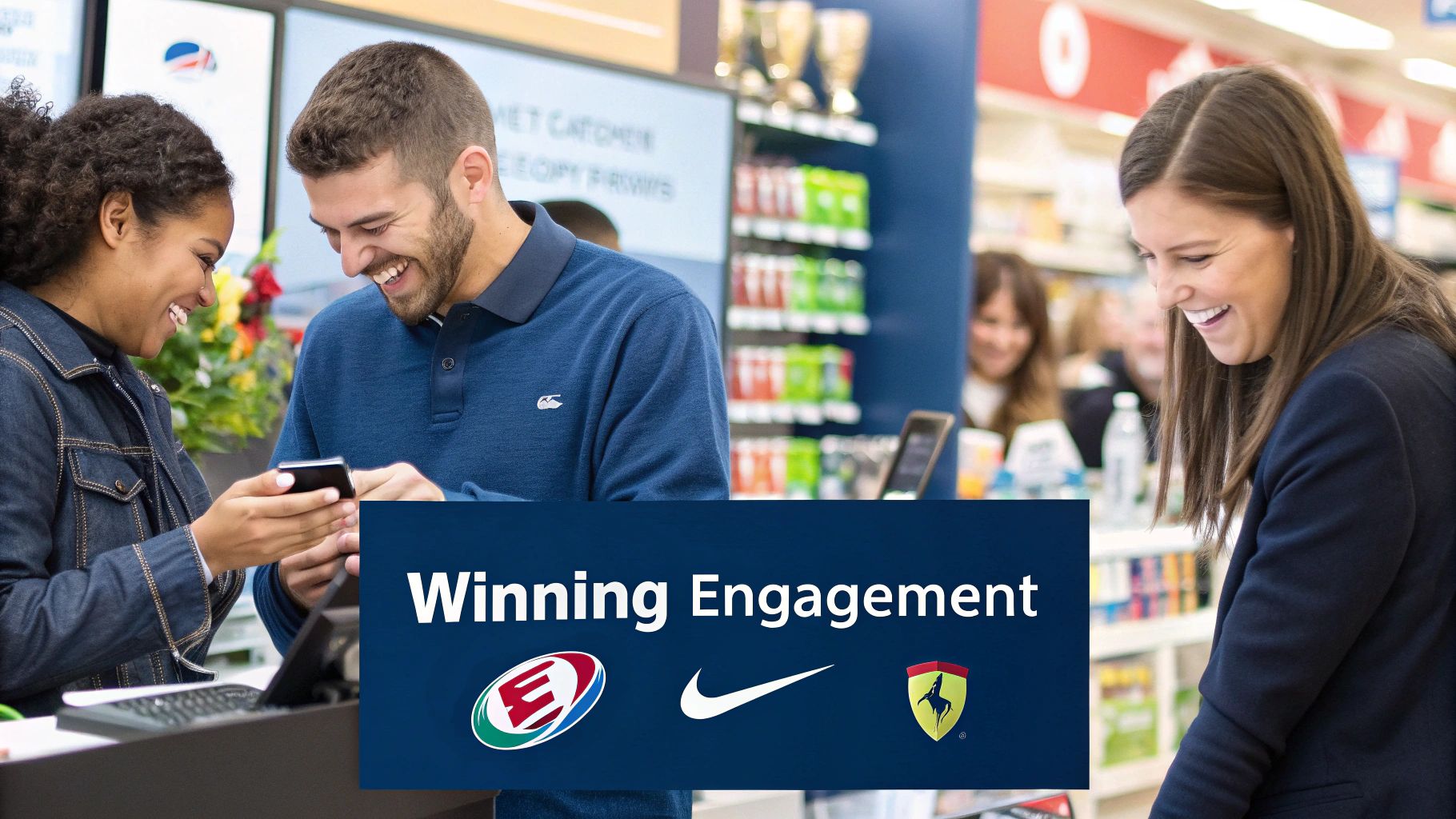
Theory is great, but seeing a powerful customer engagement plan in the wild is where the real learning happens. Let’s pull back the curtain on a few brands that have mastered the art of connection. By looking at their playbooks, we can see what makes their strategies click.
These companies do more than just push products. They build entire ecosystems where customers feel like they belong. It’s all about creating an unshakable bond with their audience, and they do it brilliantly.
Spotify Wrapped: The Masterclass in Personalization
Every year, Spotify’s "Wrapped" campaign takes over social media. It’s become a cultural moment, but at its heart, it’s a genius example of using data to create an emotional connection. The idea is simple: Spotify crunches your listening data and presents it back to you in a fun, shareable story.
But the effect is huge. Wrapped works because it makes cold, hard data feel personal. It isn’t just a report; it’s a soundtrack to your year. Suddenly, a music streaming app feels like a friend who just gets you.
Here’s why it’s so effective:
- Data as a Gift: Spotify takes your data and hands it back as a fun, insightful experience. It's a perfect way to show the value of being on the platform.
- Built-in Virality: The colorful, bite-sized slides are practically made for Instagram stories. Every user becomes a marketer, creating a massive organic buzz each December.
- Serious FOMO: All that social sharing creates a major "fear of missing out." It pulls in new users who want to be part of the fun next year.
Wrapped is the ultimate proof that an engagement plan can be both deeply personal and incredibly scalable. It uses tech to create genuine moments of delight, not just to automate tasks.
Sephora Beauty Insider: Building a Thriving Community
Sephora’s Beauty Insider is way more than a loyalty card. It’s the foundation of their entire engagement strategy, turning shoppers into a community of die-hard beauty fans who feel like they're in an exclusive club.
The program is a multi-layered experience. You earn points, sure, but you also get early access to new products, invites to special events, and a reason to climb the tiers from Insider to VIB to Rouge.
The real genius is how it blends community with commerce:
- Tiered Rewards: The system turns spending into a game. Customers push to reach the next level for better perks, which naturally increases their lifetime value.
- Exclusive Access: Offering members-only products makes customers feel special. That emotional connection is what keeps them coming back.
- The Beauty Insider Community: This is their online forum where members swap tips and talk all things makeup. Sephora becomes the hub for these conversations, turning transactions into relationships.
HubSpot Academy: The Power of Educational Content
HubSpot didn't just build great software; they built an educational powerhouse to go with it. Their engagement plan is all about teaching people to be better at marketing and sales through the free HubSpot Academy.
This strategy builds massive trust. By giving away high-value courses and certifications, HubSpot becomes an essential partner in their audience's careers. So, when it's time to buy a CRM, who do you think is top of mind?
It’s a smart play for a few reasons:
- Value-First Approach: HubSpot gives and gives long before asking for a sale. The relationship starts with trust and expertise, not a sales pitch.
- A Lead Generation Machine: The academy attracts the exact professionals who need their paid products. It’s the ultimate lead magnet.
- Reduces Churn: Customers who know how to use a product well get more value from it. Educated customers are happy customers, and happy customers stick around.
This educational model works across industries. For example, a modern real-estate chatbot can engage potential buyers by providing instant property insights and market data. These examples prove that the best engagement plans focus on building a valuable, long-term relationship, not just closing a single sale.
Frequently Asked Questions About Engagement Plans
Putting a new strategy into practice always brings up a few questions. As you start to build or tweak your own customer engagement plan, you’re bound to hit some practical speed bumps. This final section is here to help you clear those hurdles.
We’ll tackle the most common questions we hear, from dealing with tight budgets to knowing when to update your plan. Think of it as a quick-start guide to keep you moving forward with confidence.
How Do I Create a Plan with a Limited Budget?
You don't need a massive budget to build great customer relationships. You just need to be smart about where you put your energy. For smaller businesses, the name of the game is focusing on high-impact, low-cost strategies that punch above their weight.
Forget the fancy, expensive tools for now. Start by just listening to your customers. You can use free tools like Google Forms for surveys or, even better, just have real, honest conversations. Then, pick one or two channels where your people hang out the most—maybe that's email or a specific social media platform—and commit to showing up there consistently.
A simple but killer plan could look like this:
- A personalized welcome email series for every new subscriber.
- A monthly newsletter packed with genuine value, not just sales pitches.
- Actively responding to every single comment and direct message on social media.
The secret for businesses on a tight budget isn't spending more—it's being more consistent and authentic. A heartfelt, personal interaction will always outperform an expensive, generic ad campaign.
What Is the Difference Between Engagement and Experience?
This one trips a lot of people up, but getting it right is crucial. Let's think of it like hosting a dinner party.
Customer Experience (CX) is your guest's overall feeling about the whole evening. It’s the vibe—the food, the music, the conversations, the atmosphere. It’s their total perception of your brand, built from every single interaction they've ever had with you.
Customer Engagement, on the other hand, is all the stuff you do as the host to create that great experience. It’s the thoughtful invitation you sent, the menu you planned, and the great questions you asked to get the conversation flowing. Engagement is the series of actions you take; experience is the feeling your customer is left with. A great customer engagement plan is what makes a positive customer experience happen.
How Often Should I Update My Engagement Plan?
Your customer engagement plan should never be a "set it and forget it" document. It needs to be a living, breathing guide that changes as your customers and the market change. If it’s not evolving, it’s not working.
We recommend doing a major review and update at least once a year. That’s your chance to zoom out, look at the big picture, and make sure your plan still lines up with your main business goals for the year ahead.
But you should be keeping an eye on things much more frequently. Check your key metrics—like Net Promoter Score (NPS), churn rates, and repeat purchases—on a monthly or quarterly basis. If you spot a big shift in customer behavior, see a new trend emerging, or your own goals change, that's your cue to revisit the plan right away.
Ready to build stronger customer relationships automatically? ChatbotGen makes it easy to create an AI-powered chatbot that delivers instant, personalized support 24/7. Upload your content, customize the design, and start engaging customers in minutes—no coding required. Start your free 7-day trial today!
